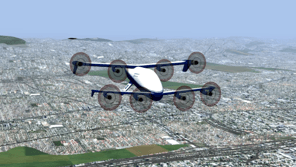Updated

Research in Flight (RIF) and Auburn University’s Vehicle Systems Dynamics and Design Laboratory (VSDDL) have made significant strides in their project, “Air Vehicle Gust Response Analysis for Early Design”, which has been selected for NASA’s Small Business Technology Transfer (STTR) Phase II program as of December 2020. This initiative is under the guidance of NASA Ames Research Center in California.
The project’s core is to develop a sophisticated and robust toolset for simulating and modeling gust and wake vortex encounters. This toolset is specifically designed for Urban Air Mobility (UAM) vehicles that utilize Distributed Electric Propulsion (DEP). The goal is to enhance the understanding of these encounters during the early stages of vehicle design, thereby identifying and addressing potential design issues more efficiently.
During Phase I, the team utilized FlightStream® to analyze the aero-propulsive behaviors of a tandem tilt-wing/rotor UAM concept under both steady and unsteady flow conditions. They also developed a MATLAB/Simulink-based simulation framework, Controls and Load Alleviation Simulation Platform (CLASP), enabling detailed time-domain simulations of aircraft flight and structural dynamics during turbulence.
The upcoming Phase II will expand upon these achievements, improving the analysis fidelity and adapting it to vertical flight scenarios. The culmination of Phase II will yield an integrated, versatile, and commercially viable simulation and analysis tool, pivotal for experts in aerodynamics, structural dynamics, and control systems.
Author: Vivek Ahuja